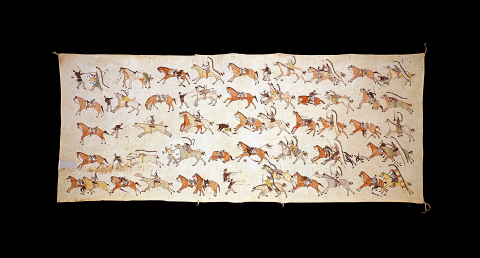
Battle of Greasy Grass (Battle of Little Bighorn)
In 1876, thousands of Lakota, Cheyenne, and Arapaho gathered in a village along the banks of the Greasy Grass River in present-day Montana. That year, on June 25, Lieutenant Colonel George A. Custer led the Seventh Cavalry in an attack against the village. Together with approximately two thousand Sioux, Sitting Bull, Crazy Horse, and other leaders resisted or fought Custer and his men, inflicting a stunning defeat on the U.S. Army, who would not experience a loss this devastating until the Balangiga conflict in the Philippines in 1901.
This muslin painting was made by Amos Bad Heart Bull (Oglála Lakota), also known as Waŋblí Wapȟáha (Eagle Bonnet), and it complements Oglála oral history traditions. Bad Heart Bull used strong outlines with overlap- ping figures to convey depth and offer a distant view of sixty individual warring figures. The repetition of the human figure also conveys the Native Americans’ relentless combat defense.